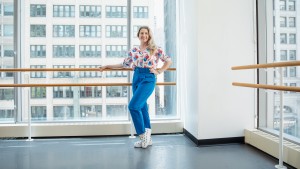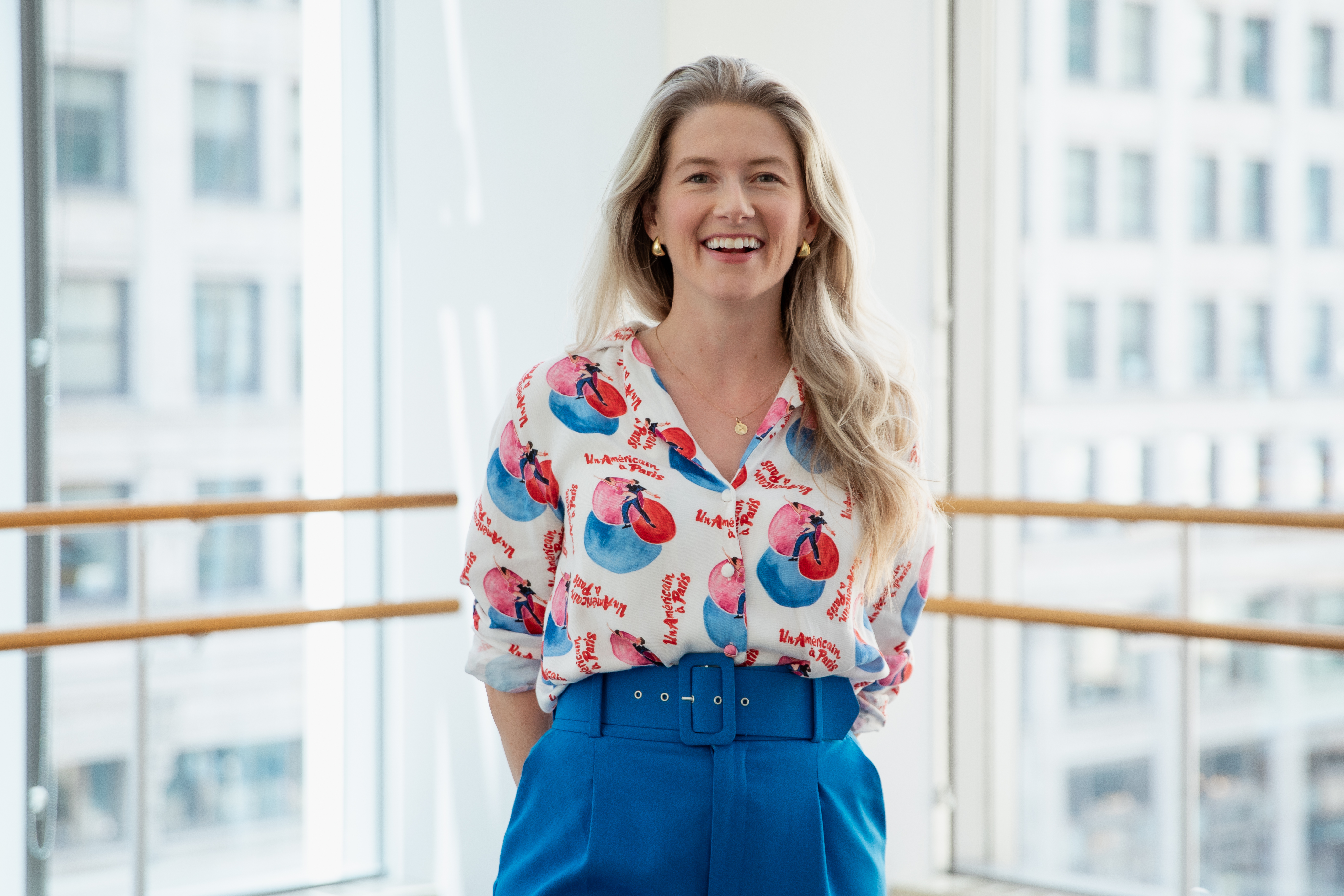Meet Amy Giancarlo, Head of Children's Program

Amy Giancarlo has recently made the leap from London to Chicago, bringing her passion for ballet education to her new role as Head of Children’s Program at the Grainger Academy of The Joffrey Ballet. Before joining the Grainger Academy family, Amy taught at The Royal Ballet School, working across both the Associate and Primary Steps Programmes.
She began her own training at the Royal Academy of Dance and later deepened her expertise through the Diploma of Dance Teaching at The Royal Ballet School. Amy is also a certified STOTT Pilates instructor and currently serves as a Trustee of the Royal Academy of Dance (RAD), elected by teaching members worldwide.
With precision and curiosity, Amy brings a fresh and thoughtful perspective to ballet training, creating an environment in the studio where young dancers can thrive.
We chatted with Amy about her dance background, teaching style, and her hopes for the Children's Program at Grainger Academy of The Joffrey Ballet.
Tell us a little about your background in dance. How did that path lead you to teaching?
From a young age, I was enthralled by my ballet teacher. She reminded me of Mary Poppins—gracious, charming, and firm… but fair. She served as a beautiful and inspirational role model in my childhood, igniting my passion for movement. She was the one who first encouraged me to pursue teaching, inviting me to assist in her classes for younger students in exchange for reduced fees. I think she saw the teacher in me long before I did!
I grew up dancing across a variety of genres, but ballet later became my focus. That path led me to the Royal Academy of Dance in London, where I completed an undergraduate degree in Ballet Education. This gave me a strong foundation in ballet alongside an appreciation for the art and science of teaching and learning.
My career then took me around the world, affording me the opportunity to share my passion for dance with students from all walks of life. In 2016, I returned to London to refine my teaching practice further, commencing the Diploma of Dance Teaching at The Royal Ballet School, where I went on to teach before relocating to the Grainger Academy this June.
As the new Head of the Children's Program, what do you hope to bring to the Grainger Academy?
I am genuinely excited to join the Grainger Academy. Inspired by the Joffrey’s commitment to innovation, inclusion and excellence, I hope to bring those same qualities to the Children’s Program.
I aim to uphold the highest standards, both artistically and educationally. This means being ambitious, reflective, and collaborative—well-organised, detail-oriented, and always asking, “How can we make this even better?” Just as I encourage my students to strive for their best, I hold myself and my colleagues to the same standards. I believe great teaching requires continual curiosity, openness to growth and thoughtful reflection. I hope to bring this mindset to the Children’s Program.
Equally, I hope to bring a forward-thinking approach. While respecting ballet’s heritage, I do not believe in doing something simply because it has always been done that way. Instead, I value evidence-based research and up-to-date best practices, using both to create the best possible environment for today’s young dancers.

How would you describe your teaching style?
I would describe my teaching style as particular! I am a stickler for the details and hold high expectations. At times, I can be demanding, but it always comes from a place of care and purpose.
I encourage students to be autonomous and reflective because I need “thinking dancers” in my class. What’s more, for me, dance is much more than learning steps; it is about developing musicality, artistry, creativity and the ability to communicate something through movement. I expect a lot, but I give a lot too, and I strive to create an environment where students feel both challenged and supported.
I also try to harness the innate creativity of children—not only for their enjoyment and engagement, but because I believe creativity and choreographic input are essential skills needed by dancers today. Increasingly, dancers are expected to collaborate with choreographers, and I believe that nurturing creativity from the very beginning helps equip them for that future.
Finally, I would not describe myself as particularly traditional; my classes are often structured in ways that deviate from convention. My approach is intentionally exploratory—pushing boundaries to advance artistic and educational excellence in order to respond to the needs of today.
In your opinion, what is the most important part of facilitating a meaningful and impactful environment for students?
For me, it begins with having a genuine belief in every student, regardless of their ability. Fostering a growth mindset is also key—encouraging students to see challenges as opportunities and mistakes as part of the learning process.
I also want my students to think for themselves, develop autonomy, and take ownership of their learning, because this is what sets them up for success in the long run.
At the same time, the teacher has a vital role in creating the optimal studio climate—one that is inclusive, structured, and purposeful, with high expectations balanced by warmth and care. I am always mindful of the enormous responsibility that comes with teaching, and I often return to Haim Ginott’s words:
“I’ve come to a frightening conclusion that I am the decisive element in the classroom. It’s my personal approach that creates the climate. It’s my daily mood that makes the weather. As a teacher, I possess a tremendous power to make a child’s life miserable or joyous. I can be a tool of torture or an instrument of inspiration. I can humiliate or heal. In all situations, it is my response that decides whether a crisis will be escalated or de-escalated and a child humanized or dehumanized.”
What is one thing you would like your students to walk away with each day?
After the lesson, I want my students to leave the studio with a smile, feeling that they have truly worked both body and mind. Growth comes from stepping beyond one’s comfort zone, so I hope they feel positively challenged and inspired.
I believe it is important that each student leaves every lesson able to articulate at least one thing they have learned, achieved or enjoyed. If they cannot, I take that as valuable feedback on my teaching. If they can, that sense of accomplishment not only builds confidence but also helps them to recognise their own progress—even when it feels gradual. This is important because ballet offers no quick fixes; true mastery requires time, patience and persistence.
Above all, I want my students to walk away with more than just dance skills - perseverance, commitment, self-belief, and joy in the process of learning—qualities that will serve them well both in the studio and in life.
We'd love to hear a fond memory of yours while dancing in class as a child. How does that experience inspire you today?
One of my most formative experiences was dancing in Coppélia with English Youth Ballet, a touring youth company, when I was about 12. It was my first time learning repertoire, and I had only just begun pointe work. It was a challenge—I was passionate, but not the most naturally gifted. Still, I had determination and a strong work ethic, which the Assistant Director, Dominic Marshall, recognised. He appointed me “dance captain,” which felt like an enormous responsibility and privilege, especially at such a young age.
That moment was a true lightbulb for me. It showed me that grit and perseverance matter just as much, if not more, than natural talent. His belief in me helped set me on this path, and it continues to inspire me to foster that same quality in my own students. A career in dance is deeply rewarding, but it is also incredibly demanding, and as the saying goes, “hard work beats talent when talent doesn’t work hard.” Through experience, I have come to learn that inner strength and intrinsic motivation are often what set excellent dancers apart from good dancers—and what ultimately sustain them over the course of a long career.
In recent years, some of my own students have performed with English Youth Ballet, where Dominic still teaches. After watching them, I went to the stage door, reintroduced myself, and shared the impact he had made on me. He seemed moved, and it was a full-circle moment that reminded me of the profound, lifelong influence a teacher can have… so Dominic, if you are reading this, once again - thank you!
Learn more about the Grainger Academy of The Joffrey Ballet's Children's Program here.